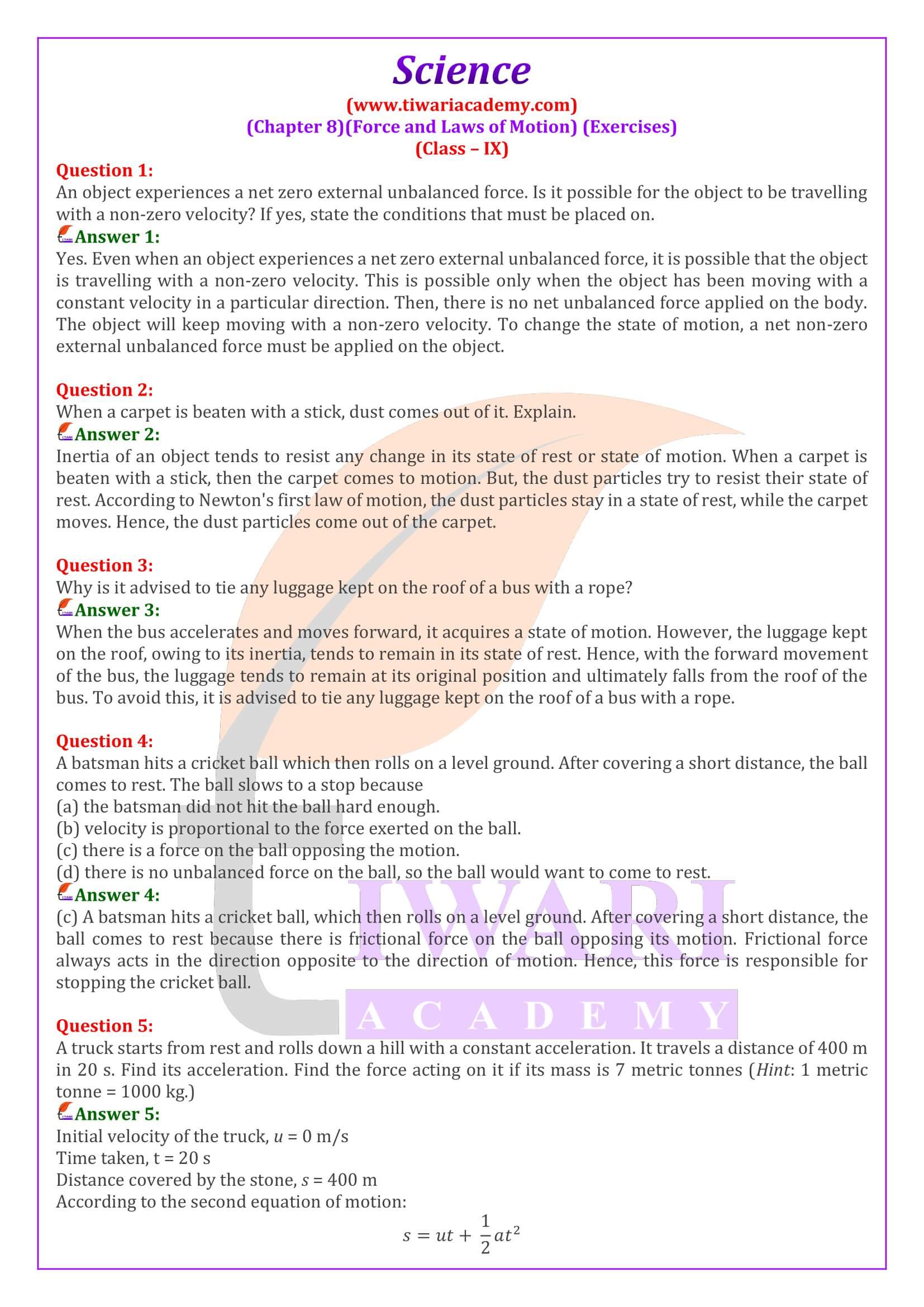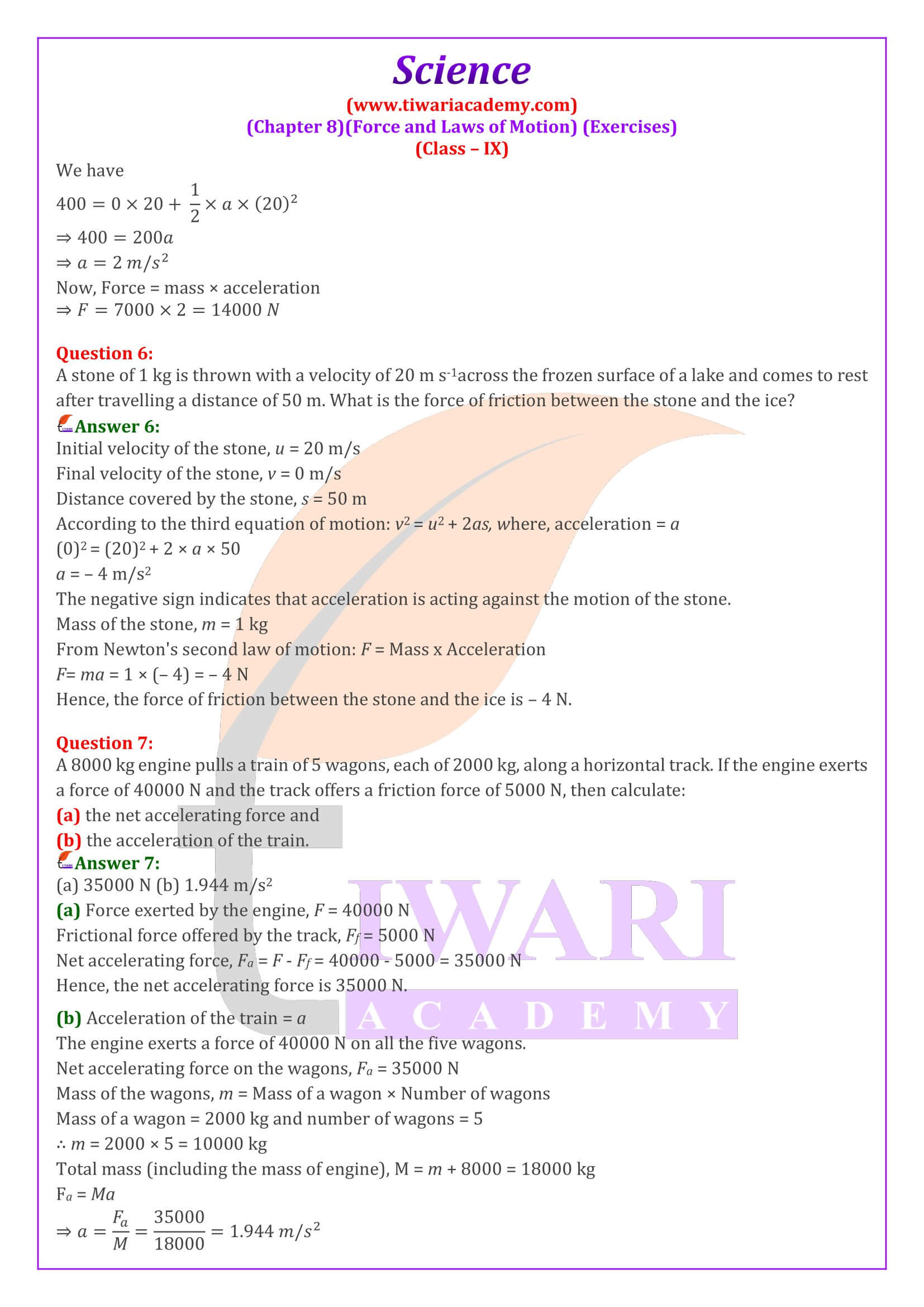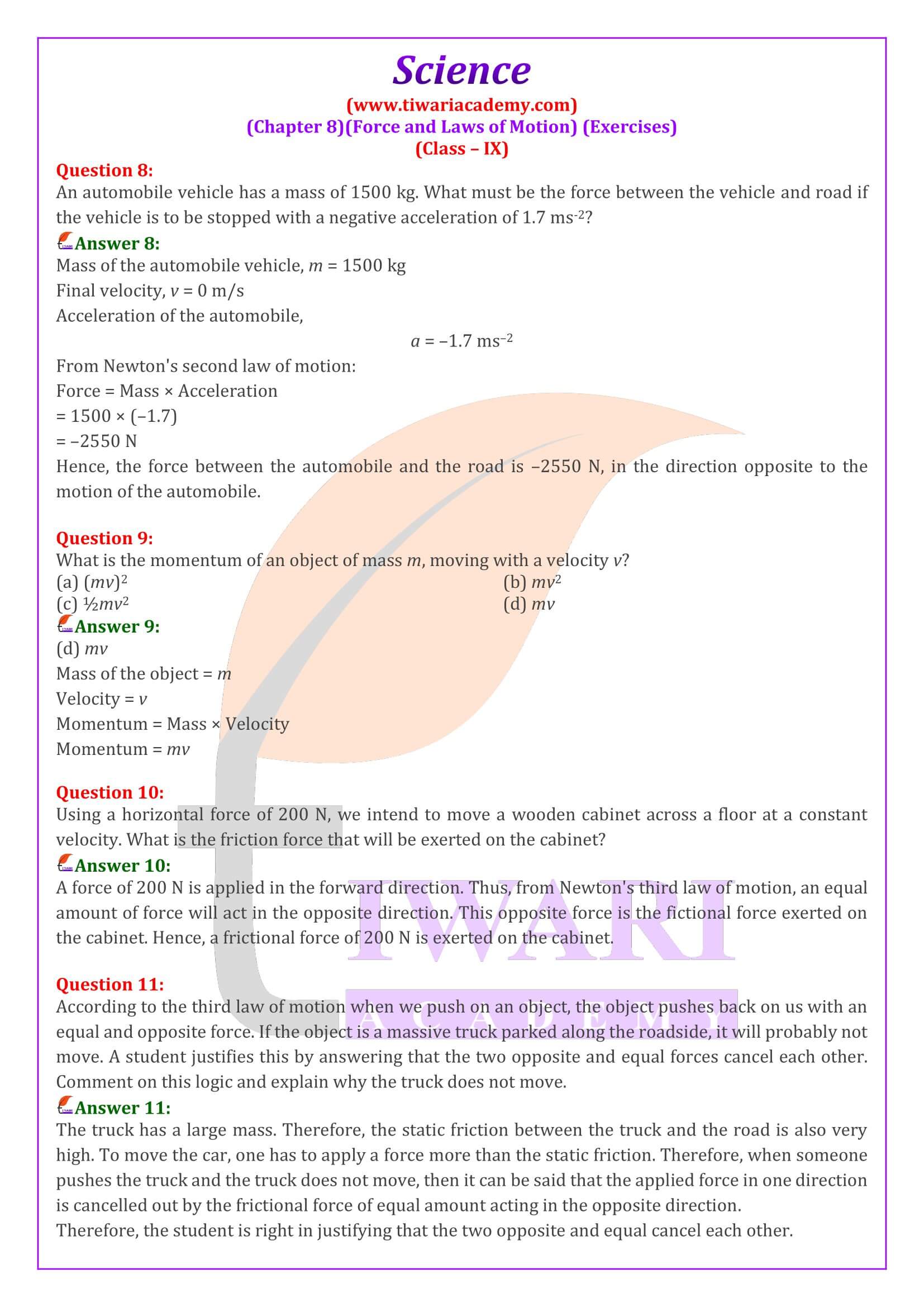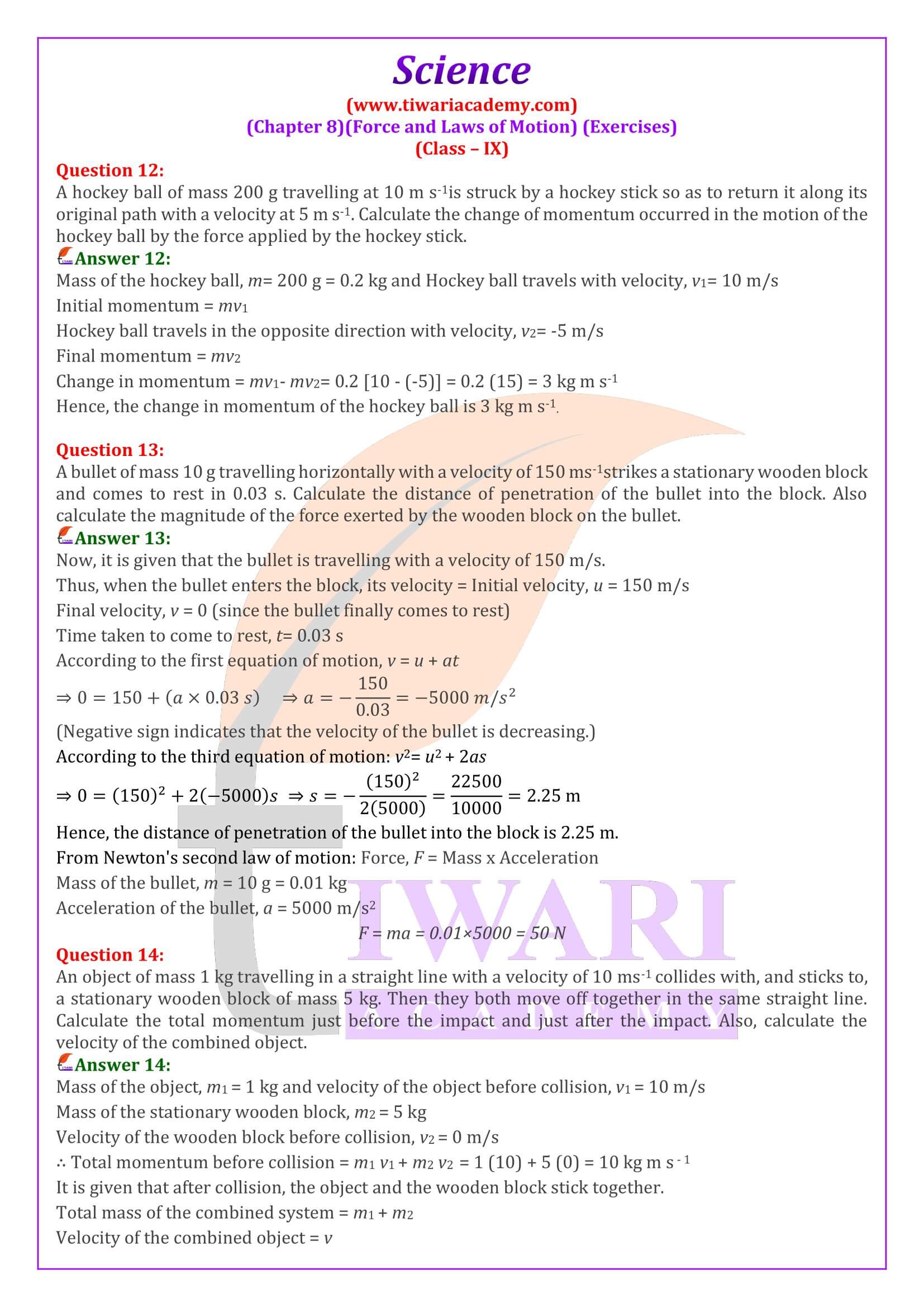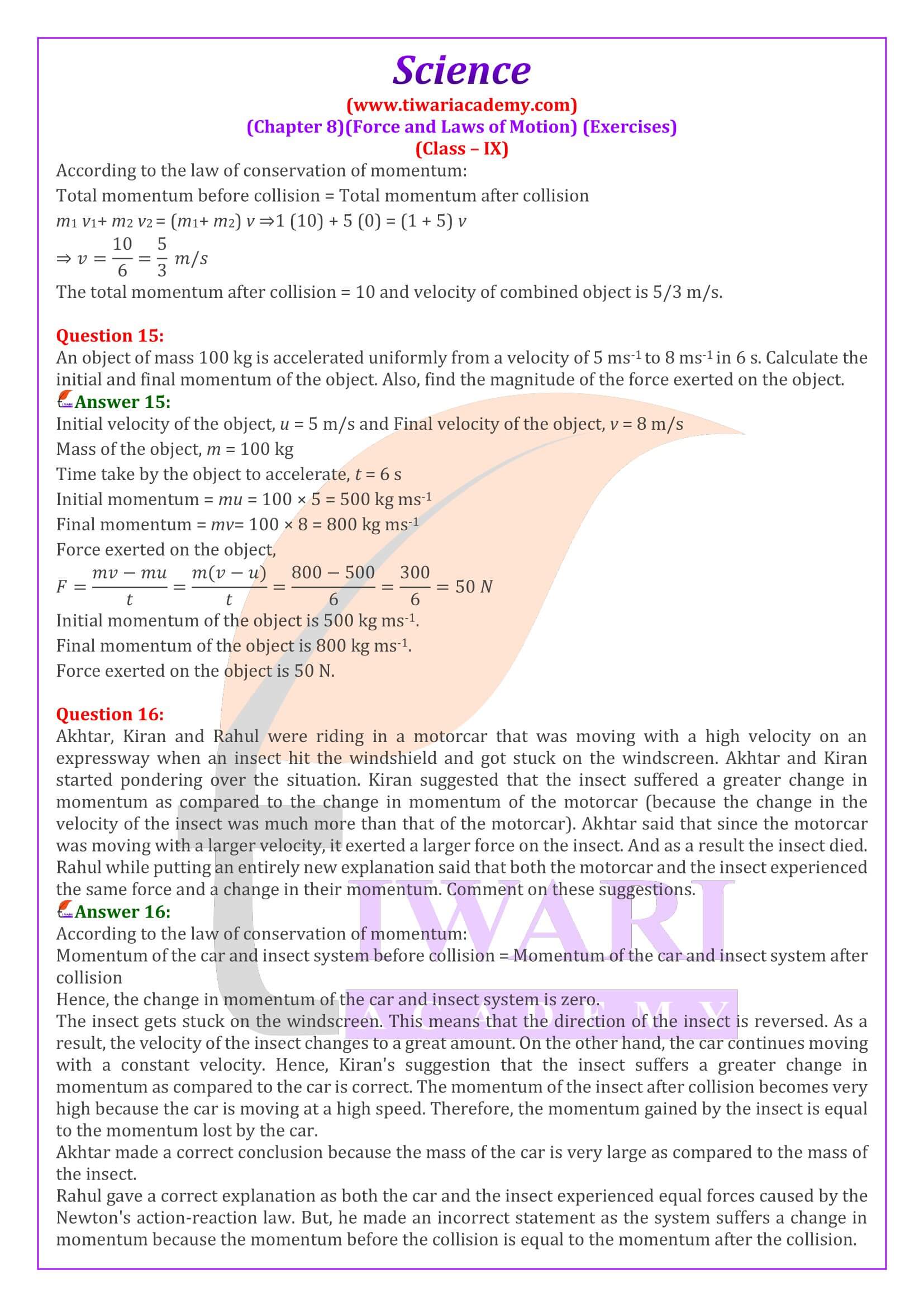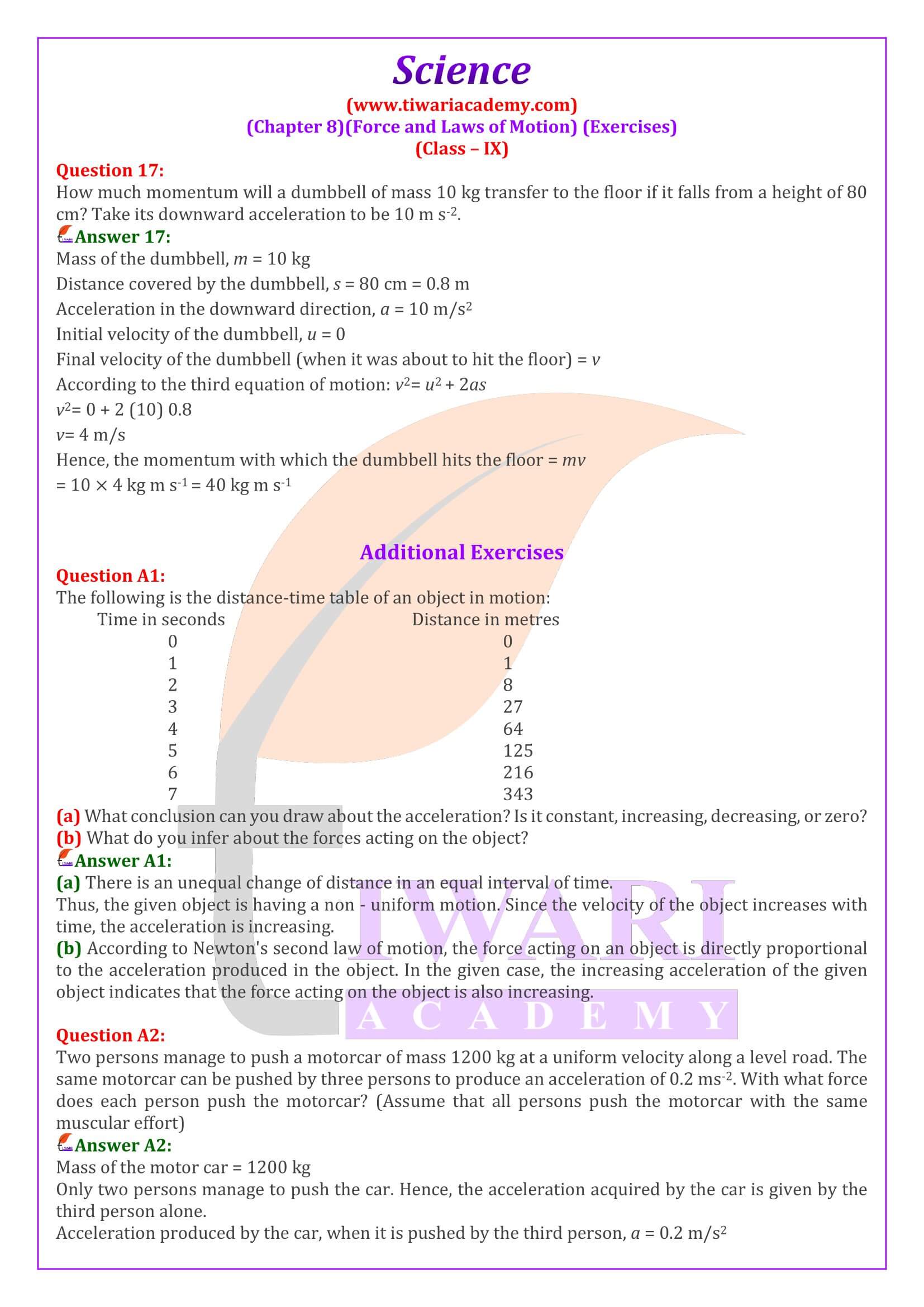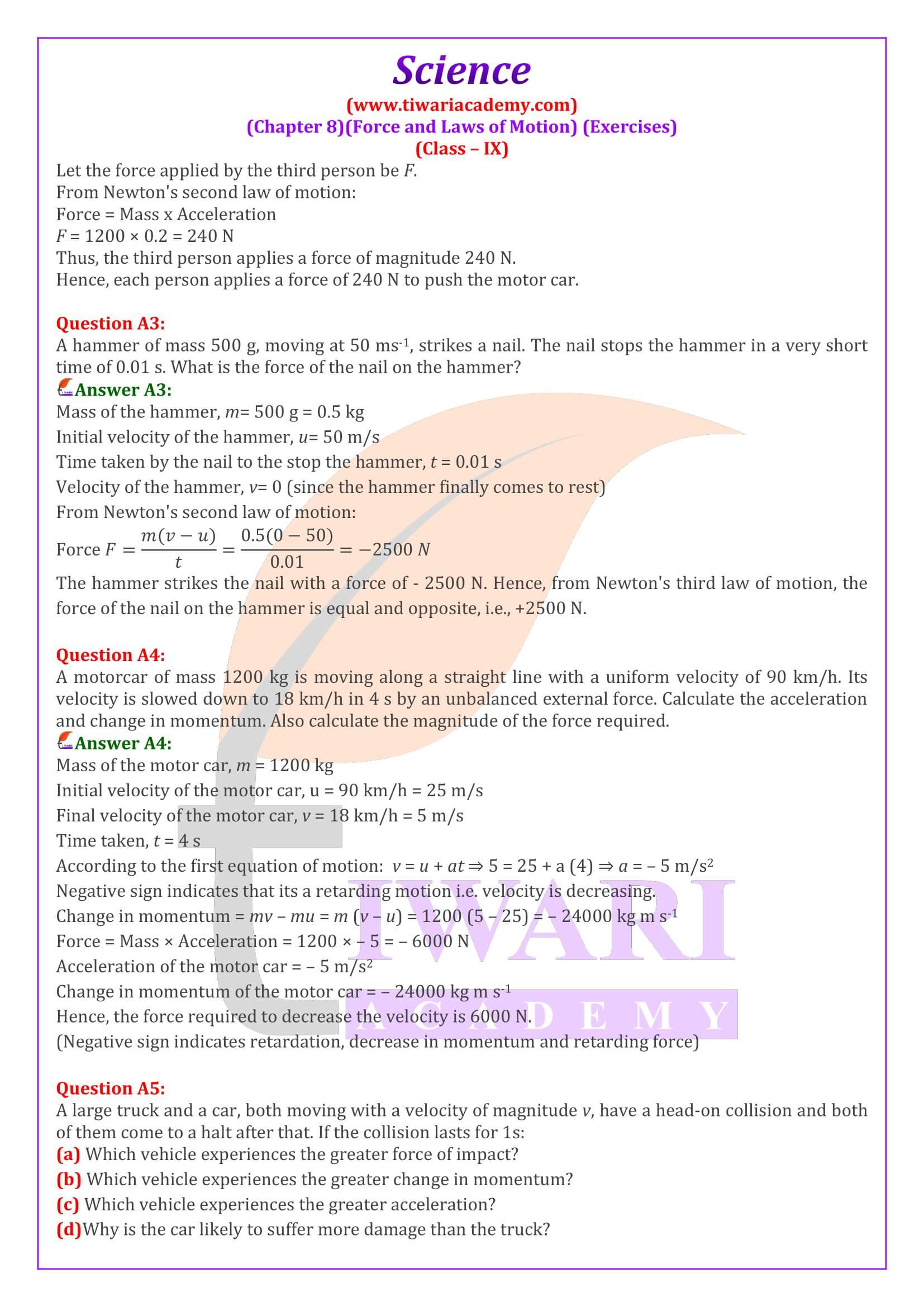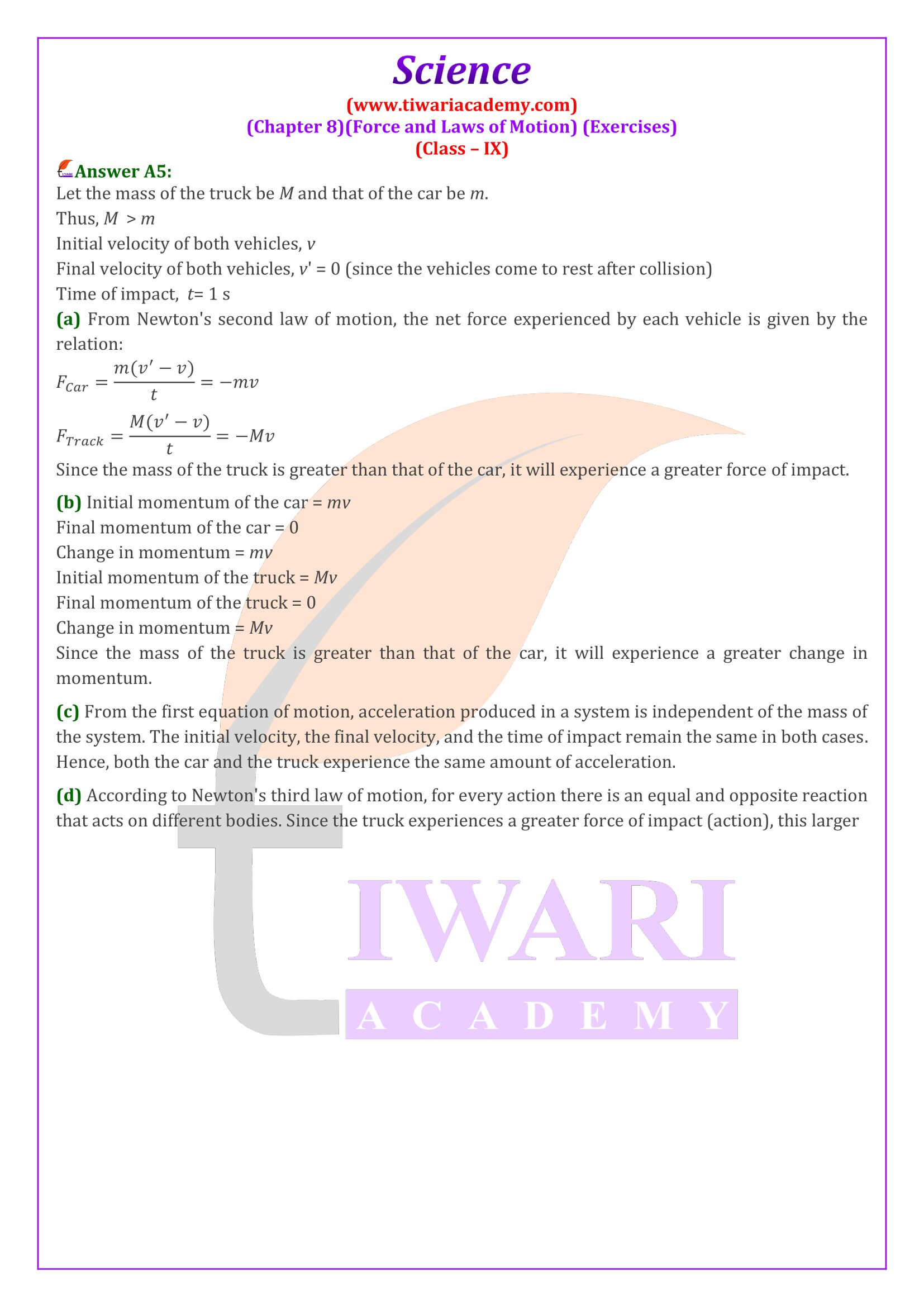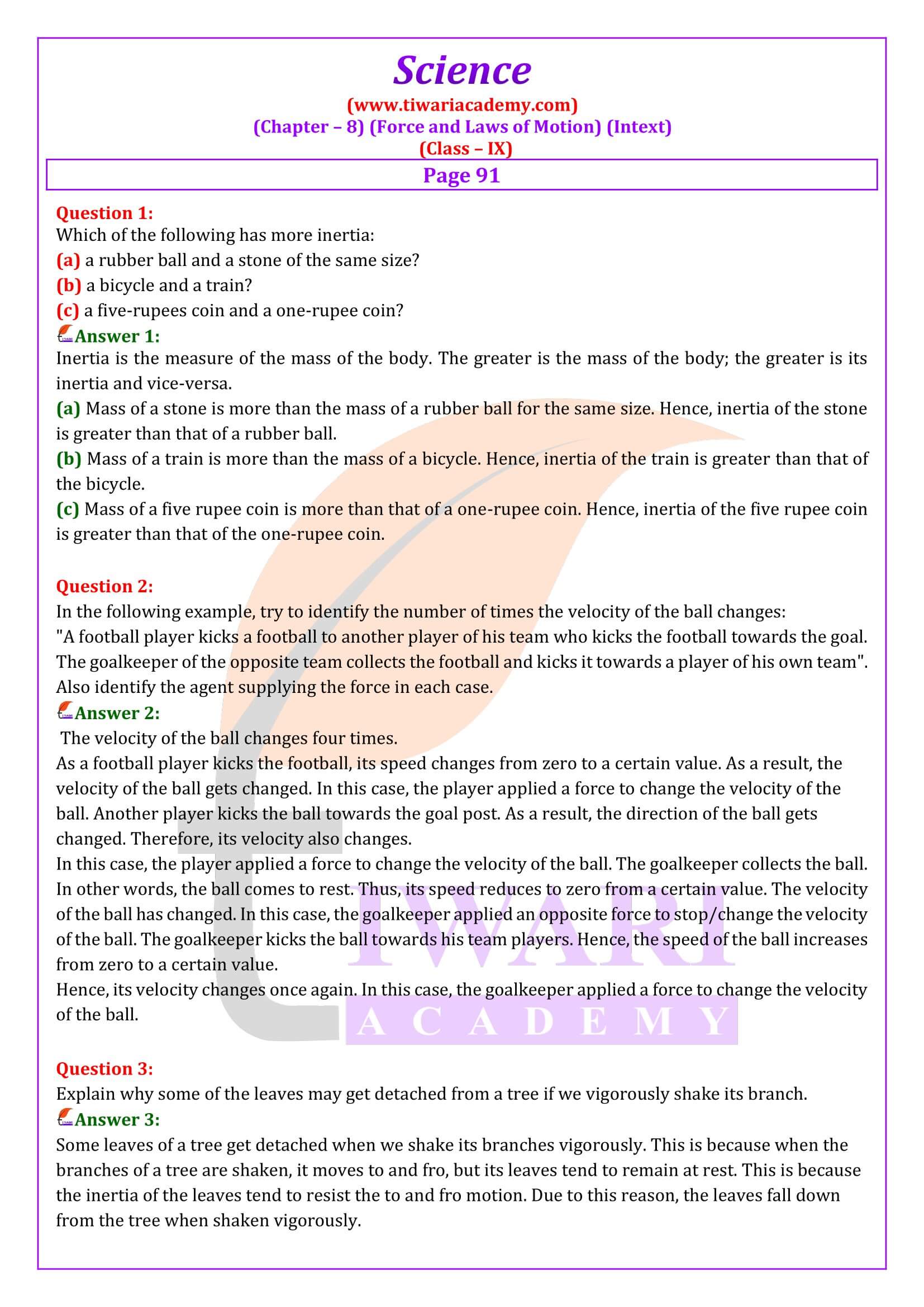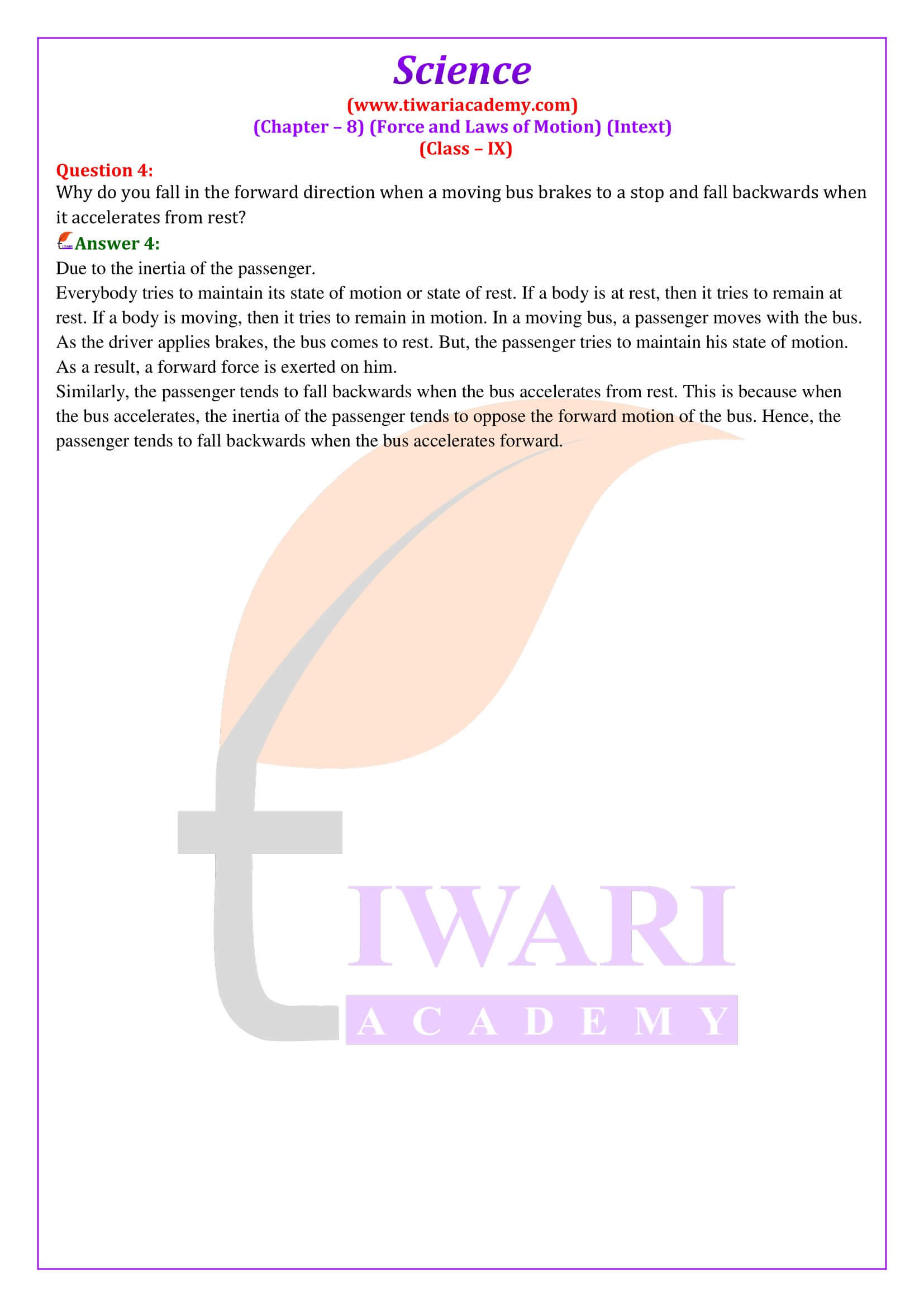NCERT Solutions for Class 9 Science Chapter 8 force and laws of motion in Hindi and English Medium for CBSE session 2025-26. The solutions of chapter 8 class 9th Science is modified according to rationalised NCERT textbooks published for academic year 2025-26.
Class 9 Science Chapter 8 Question Answers
- Class 9 Science Chapter 8 Exercises
- Class 9 Science Chapter 8 Intext Questions
- Class 9 Science Chapter 8 Extra Questions
- Class 9 Science Chapter 8 Hindi Medium
- Class 9 Science Chapter 8 Notes in English
- Class 9 Science Chapter 8 Notes in Hindi
- Class 9 Science Chapter 8 NCERT Book
- Class 9 Science NCERT Solutions
- Class 9 all Subjects NCERT Solutions
NCERT Solutions for Class 9 Science Chapter 8
Class IX Science chapter 8 Intext questions given on Page 118, Page 126, Exercises or Additional Exercises. MP Board and UP Board students can download here UP Board Solutions in Hindi Medium. Hindi Medium solutions of Class 9 Science chapter 8 Bal tatha Gati ke Niyam ke Page 131 ke Uttar, Page 140 ke Uttar, Abhyaas ke Uttar ya Atirikt Abhyaas ke Uttar are also available in PDF download or study online free. NCERT Solutions 2025-26 for class 9 all subjects and Offline CBSE Apps based on these solutions of class 9 (ix) is given in Hindi and English Medium Download free.
Extra Questions on 9th Science Chapter 8
A body of mass 1 kg is kept at rest. A constant force of 6∙0 N starts acting on it. Find the time taken by the body to move through a distance of 12 m.
2 seconds
A truck of mass 2500 kg moving at 15 m/s collides with a car of mass 1000 kg moving at 5 m/s in the opposite direction. With what velocity would the two move together?
9∙3 m/s in the direction of the truck.
A feather of mass 10 g is dropped from a height. It is found to fall down with a constant velocity. What is the net force acting on it?
Zero
A bullet of mass 20 gram moving with a velocity of 300 m/s gets embedded in a freely suspended wooden block of mass 880 gram. What is the velocity acquired by the bock?
6∙67 m/s
A machine gun fires 25 g bullets at the rate of 600 bullets per minute with a speed of 200 m/s. calculate the force required to keep the gun in position.
50 N
A motorcar is moving with a velocity of 108 km/h and it takes 4 second to stop after the brakes are applied. Calculate the force exerted by the brakes on the motorcar if the mass along with the passengers is 1000 kg.
-750 N
| Class: 9 | Science |
| Chapter 8: | Force and Laws of Motion |
| Study Material: | Intext, Exercise and Extra Questions |
| Content Mode: | Text, PDF and Videos Format |
| Academic Session: | 2025-26 |
| Medium: | Hindi and English Medium |
9th Science Chapter 8 Answers in English & Hindi Medium
NCERT Solutions for Class 9 Science Chapter 8 force and laws of motion all Intext questions given with in the chapter and end exercise given at the end of the chapters are given below. Additional Exercises solutions and Class 9 Science offline apps 2025-26 in Hindi and English Medium are also given to download free.
Questions for Practice on 9th Science Chapter 8
Important Questions on 9th Science Chapter 8
An object experiences a net zero external unbalanced force. Is it possible for the object to be travelling with a non-zero velocity? If yes, state the conditions that must be placed on the magnitude and direction of the velocity. If no, provide a reason.
Yes. Even when an object experiences a net zero external unbalanced force, it is possible that the object is travelling with a non-zero velocity. This is possible only when the object has been moving with a constant velocity in a particular direction. Then, there is no net unbalanced force applied on the body. The object will keep moving with a non-zero velocity. To change the state of motion, a net non-zero external unbalanced force must be applied on the object.
When a carpet is beaten with a stick, dust comes out of it. Explain.
Inertia of an object tends to resist any change in its state of rest or state of motion. When a carpet is beaten with a stick, then the carpet comes to motion. But, the dust particles try to resist their state of rest. According to Newton’s first law of motion, the dust particles stay in a state of rest, while the carpet moves. Hence, the dust particles come out of the carpet.
Why is it advised to tie any luggage kept on the roof of a bus with a rope?
When the bus accelerates and moves forward, it acquires a state of motion. However, the luggage kept on the roof, owing to its inertia, tends to remain in its state of rest. Hence, with the forward movement of the bus, the luggage tends to remain at its original position and ultimately falls from the roof of the bus. To avoid this, it is advised to tie any luggage kept on the roof of a bus with a rope.
Using a horizontal force of 200 N, we intend to move a wooden cabinet across a floor at a constant velocity. What is the friction force that will be exerted on the cabinet?
A force of 200 N is applied in the forward direction. Thus, from Newton’s third law of motion, an equal amount of force will act in the opposite direction. This opposite force is the fictional force exerted on the cabinet. Hence, a frictional force of 200 N is exerted on the cabinet.
Question 1:
A girl of mass 40 kg jumps with a horizontal velocity of 5 m/s onto a stationery cart with friction-less wheels. The mass of the cart is 3 kg. What is her velocity as the cart starts moving? Assume that there is no external unbalanced force working in the horizontal direction.
Answer 1:
4∙65 m/s
Question 2:
According to the third law o motion, when we pushed on an object, the object pushes back on us with an equal and opposite force. If the object is a massive truck parked along the roadside, it will probably not move. A student justifies this by answering that the two opposite and equal forces cancel each other. Comment on this logic and explain why the truck does not move.
Answer 2:
When we push a massive truck parked along the roadside, it does not move. The justification given by the student that the two forces and equal forces cancel each other is totally wrong. This is because forces of action and reaction never act on one body. There is no question of their cancellation. The truck does not move because the push applied is far less than the force of friction between the truck and the road. We also do not move because the force of reaction acting on us (due to our pushing the truck) is less than force of friction between us and the road.
Question 3:
A constant force acts on an object of mass 5 kg for a duration of 2 s. It increases the object’s velocity from 3 m/s to 7 m/s. Find the magnitude of the applied force. Now if the force were applied for the duration of 5 s, what would be the final velocity of the object.
Answer 3:
10 n ; 13 m/s
